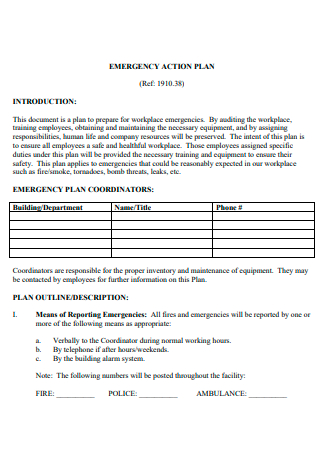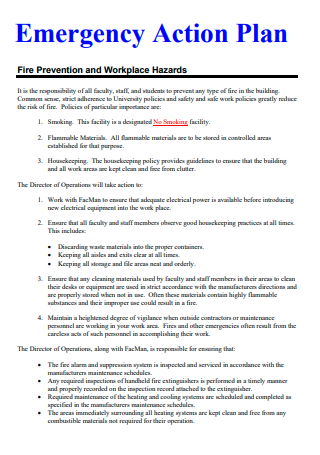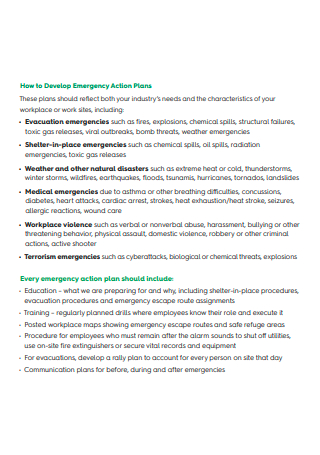10+ Sample Workplace Emergency Action Plan
-

Workplace Emergency Action Plan Template
download now -

Workplace Emergency Action Plan Checklist
download now -

Workplace Emergency Action Plan in PDF
download now -

Basic Workplace Emergency Action Plan
download now -

Violence in Workplace Emergency Action Plan
download now -

Workplace Emergency Action Plan Example
download now -

Fire Prevention and Workplace Hazards Emergency Action Plan
download now -

Company Workplace Emergency Action Plan
download now -

Printable Workplace Emergency Action Plan
download now -

Standard Workplace Emergency Action Plan
download now -

Sample Workplace Emergency Action Plan
download now
FREE Workplace Emergency Action Plan s to Download
10+ Sample Workplace Emergency Action Plan
What Is a Workplace Emergency Action Plan?
Why Is an Emergency Action Plan Important?
What Are the Types of Workplace Emergencies?
4 Elements of A Workplace Emergency Action Plan:
How to Handle Workplace Emergencies:
6 Key Steps to Emergency Planning:
FAQs
How do you act in an emergency situation?
What is a good emergency plan?
What are the emergency dos and don’ts?
What Is a Workplace Emergency Action Plan?
Identifying a workplace emergency situation is essential to being able to respond appropriately and quickly. Some healthcare settings, such as emergency departments, will be confronted with emergency situations as routine. A workplace emergency, however, refers to an unexpected situation that threatens employees, residents and patients, and members of the general public; disrupts or completely shuts-down facility operations; or causes physical and/or environmental damage.
An emergency plan is a set of instructions outlining what to do in an emergency situation, and must include the emergency procedures and responses to emergencies; evacuation procedures; notifying emergency services as soon as possible; directions for any medical treatment and assistance required; effective communication between the authorized emergency response coordinator and the rest of the workplace; testing of the emergency procedure; and information, training and instruction to relevant workers in relation to implementing the emergency procedures.
Why Is an Emergency Action Plan Important?
Workplace emergencies come in a variety of forms. Most potential emergencies will be specific to certain industries and work environments, whereas others are more global, presenting a risk to all workplaces. Understanding the types of emergencies your workplace may experience is the first step in being able to plan and train for their occurrence.
Moreover, a workplace emergency is an event that occurs and endangers employees, clients, or the public; or risks disrupting the workplace operations; or causes damage. Emergencies can take many forms, but will largely fall into three categories — natural, work-related, and external.
One example of an emergency action plan is in a care setting such as a residential care facility where the stakes of an emergency are often complex, due to the number of infirm or immobile residents. If a full evacuation during an emergency is necessary, it is important to be aware of the facility’s evacuation procedures. People’s needs will vary in an emergency situation. The emergency response coordinators should give some special consideration to managing the evacuation of vulnerable people when developing an evacuation plan. Some recommended planning strategies could include the following:
People using wheelchairs and mobility devices: Keep wheelchair ramps and access points free. If in a multi-story building, elevators should not be used – particularly if there is a fire. If a person using a wheelchair cannot easily get out of the building, fire-isolated stairwells can provide limited safe refuge during a fire, until emergency services arrive. Ensure the building’s fire warden is notified about this.
People who are deaf or hard of hearing: Flashing light-alarms should accompany any emergency alarms, or if not available, persons should be tasked with notifying and assisting residents with hearing loss.
People with cognitive impairment and disability: People with cognitive impairment and disability may have difficulty recognizing an emergency. Assigning an evacuation ‘buddy’ can help reduce stress and provide support and guidance in this situation.
People who are blind or have low vision: Ensure fire-escape stairwells are sufficiently lit and alarms can be heard in all rooms of the facility.
Have a plan for alternate accommodation: In the event of a facility-wide evacuation, residential aged care facilities should identify alternative accommodation options for relocation.
What Are the Types of Workplace Emergencies?
Some of the examples of emergency situations can include:
Regardless of the type of emergency your workplace experiences, it is important to be prepared so that the damage to the employees, customers, and business is minimized as much as possible. Making decisions during a crisis can be tough even for the calmest level-headed among us, so having a well-thought-out emergency plan that clearly outlines the steps and actions to be taken is crucial, and also legally required.
4 Elements of A Workplace Emergency Action Plan:
- Prevention—policies and procedures to minimize the occurrence of emergencies
- Preparation—activities and procedures to make sure your organization is ready to effectively respond
- Response—the action to be taken when an emergency occurs
- Recovery—practices to resume to normal business operations
How to Handle Workplace Emergencies:
The best way to prepare for an emergency and minimize the damage is to have a well-thought-out plan in place.
The first step in creating a plan is to brainstorm the worst-case scenarios that could happen to a workplace. Natural and civil type emergencies will be mostly universal to all workplaces, although the responses may differ. The complicated part is evaluating emergencies that may result from aspects directly related to the work you do. A good starting point is to use a previous risk assessment that identifies the risks, and ways to mitigate them, in the workplace. But emergency plans should also account for unexpected risks that could develop into an emergency situation.
The plan itself should be made to the specific workplace as each work environment will have different risks that could lead to emergencies, and there will likely be different logistical considerations when handling them. They should all include the same core features like:
Chain of Command. Having a clear chain-of-command will help prevent any confusion during an emergency. The plan should include details of the appointed coordinator and a backup option. The coordinator’s job will be to oversee the emergency response, communicate and liaise with internal and external emergency response and service teams, ensure that any operations or areas are shut down and secured where required, and make sure that all at-risk personnel are notified and evacuated.
Emergency Response Personnel. Listed within the plan should be a number of designated emergency response personnel, their designated roles, and backup personnel in the case of the primary appointees being unavailable. Emergency response personnel will be responsible for dedicated tasks such as fire safety or medical assistance. They could also include personnel trained in special tasks such as the handling, control, and cleanup of toxic or hazardous chemical spills, depending on the work environment and its hazards.
Emergency Equipment. Being able to respond quickly to emergencies is crucial in limiting damage. The location of items such as automatic external defibrillators, fire extinguishers, chemical containment equipment, machinery controls, and water mains access points should be included here. The details and locations of any and all emergency equipment should be clearly listed for the benefit of both emergency response teams within the company and emergency service personnel.
Evacuation Procedures. Include the details of any evacuation procedures that may be required during an emergency. Take note of the details of emergency exits, the location of stairs to avoid lifts, and the location of rally points where employees should assemble once evacuated to prevent interference with emergency personnel and allow for easy head counts.
Alarms. Another core feature of the plan should be details of the alarms that will sound during an incident, what they mean, and the expected action from employees. This is important as different actions may be required for different types of emergencies; for instance, employees will be expected to evacuate during a fire, but during machinery malfunction, they may be required to lock down their area and stay in position to prevent further injury.
Additional Inclusions. It can be a good idea to include information within the plan as to a location for engagement and communication during an emergency out with the workplace, and a location where important documents and data are backed-up. Moreover, it can also be useful to include a point of contact for employees to receive updates in the hours and days after the emergency, like if they should return to work.
6 Key Steps to Emergency Planning:
Step 1: Establish the planning team. It is most effective to have representatives from all departments and levels, with support from senior management.
Step 2: Assess the risks and company capabilities.
Step 3: Develop the emergency response plan together with the emergency response team.
Step 4: Implement the plan by obtaining equipment, communicate, and train.
Step 5: Test the plan by conducting drills or simulation exercises.
Step 6: Review and improve the plan continuously.
FAQs
How do you act in an emergency situation?
Steps to take when an emergency situation occurs:
- Take a deep breath.
- Count to 10. Tell yourself you can handle the situation.
- Check for danger. Protect yourself and the injured person from fire, explosions, or other hazards.
- Try to look at the situation as a whole because the most obvious problem is not always the most serious.
- Treat the most life-threatening problems like bleeding or shock first.
- If you think the person has a spinal injury, do not move him or her unless the danger is great.
- Check for broken bones and other injuries.
- If the person is unconscious or does not respond to your voice or touch, be ready to start CPR.
What is a good emergency plan?
Emergencies can strike at any time and many can be anticipated with thorough research. Thorough workplace preparedness emergency plans should consider employee safety procedures—particularly in the event of last-minute emergencies—contingency plans to deal with workplace damages, personnel equipment, any evacuation procedures, and establish a chain of command. An effective workplace emergency plan should remain personnel-focused, including clear communication about what to do during and after the disaster. The primary goals of the plan are protecting lives and property in an emergency. It should give concise instructions and methods for reporting hazards and emergencies. It should also include evacuation procedures, emergency escape routes, and consider any hazards within the workspace. Outlining the rescue and medical duties for designated workers is important. Include contact information for individuals inside and outside the company who can be contacted for further details on the responsibilities and duties contained within the emergency plan. Get a list of procedures for the employees who must remain within the worksite for essential work functions.
Employers should consult with local health agencies and public safety authorities on any plans and ensure regulations are adhered to as part of the planning process. All staff should receive training on emergency preparedness to ensure they are knowledgeable about any plans in place. Company drill exercises are a useful tool to ensure employee engagement in this area. All escape routes, evacuation procedures, safety personnel contacts and emergency contact information should be established and effectively communicated to staff, along with the final plans.
What are the emergency dos and don’ts?
Dos
- Communicate to your family, friends, co-workers, and neighbors about emergency preparedness.
- Follow the directions of your public safety officials.
- Have a regular cord phone. Cordless phones that depend on an electrical base may not work if power is out.
- Have an emergency “go” kit ready. Collecting flashlights, batteries, first aid kits, clocks, radio, important papers in the midst of an emergency is not a good idea. Most people have gym bags, fishing boxes, why not an emergency “go” kit?
- Have at least 1 out-of-state contact. If circuits are busy, you stand a better chance of reaching someone further away.
- Have enough medicine.
- Have extra cell phone batteries or power-banks.
- Include your pets in your plan. If you must leave your home in an emergency, take your pets.
- Keep a wallet-sized list of your contact information and meeting places with you at all times.
- Keep cash on hand.
- Keep gas in your car.
- Keep your photo negatives in a watertight envelope along with your important papers in your “go” kit. Photo albums are the number 1 possession that people regret losing.
- Review your plan and kit seasonally.
- Share resources and car pool in major emergency evacuations. stop and think and use common sense in an emergency.
- Store water and food for an extended period of time.
Don’ts
- Don’t call an emergency hotline unless there is a life-threatening emergency.
- Don’t drink, eat, or smoke anything during an emergency from a chemical source or unknown explosion until you are out of the harm’s way.
- Don’t go anywhere except to your designated meeting place after escaping from an emergency scene. The fire or police personnel shouldn’t be risking their lives searching for you because they don’t know you got out safely.
- Don’t go to a shelter without your pets and don’t leave your pets behind.
- Don’t go to any emergency scene.
- Don’t have long conversations on your cell phone as it will quickly deplete your batteries and you may not be in a position to recharge your phone.
- Don’t have predetermined evacuation routes. In a hazardous material incident, the direction of the wind and weather conditions will dictate which way to go.
- Don’t leave behind any food, water, medicine, or clothing you might need when going to a shelter.
- Don’t make assumptions.
- Don’t panic. Always think before you act.
- Don’t travel downwind of a chemical incident.
It may seem challenging to understand what it means to be prepared when it seems that each day presents the possibility of new hazards happening on the job. However, there are tangible steps business owners and employers can take to make sure that when the unexpected occurs, the response can be quick, efficient, and not compromised by confusion.
Generally, in order to prepare for the unpredictable and unprecedented, employers should evaluate potential risks and determine which disasters and hazards may cause a potential threat to their workplace and the safety of their staff. This can include natural hazards such as floods, tornadoes, and earthquakes, health hazards, including localized illnesses and global disease outbreaks such as COVID-19, as well as human-caused danger like workplace accidents. Remember to acknowledge the importance of being prepared for all emergencies.
